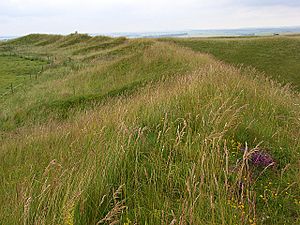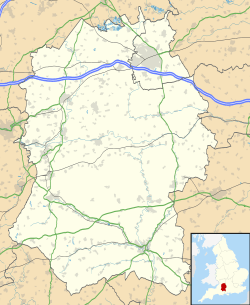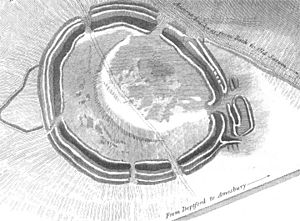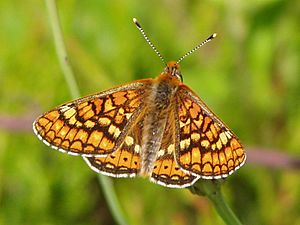Yarnbury Castle facts for kids

The earthwork ramparts and ditches of Yarnbury Castle
|
|
| Location | Wiltshire |
|---|---|
| Region | Southern England |
| Coordinates | 51°09′47″N 1°57′04″W / 51.163°N 1.951°W |
| Type | hillfort |
| Area | 28.5 acres (11.5 ha) |
| Height | 167 m (548 ft) |
| History | |
| Material | Chalk |
| Founded | Iron Age |
| Site notes | |
| Excavation dates | 1932, 1987 |
| Archaeologists | Mrs.M.E.Cunnington RCHME |
| Public access | No |
Yarnbury Castle is the site of a very old hillfort from the Iron Age. It is located near the village of Steeple Langford in Wiltshire, England. This ancient site covers an area of about 28.5 acres (11.5 hectares).
Experts from the Royal Commission on the Historical Monuments of England studied the site in 1991. They found many interesting things. These included pottery and coins from the Iron Age and the Roman times. They also found human remains.
There is a lot of proof that people lived here for a long time. Archaeologists found signs of about 130 buildings. These were likely round houses, storage pits, and other structures.
The earthworks of Yarnbury Castle are also a special place for nature. It is called a Site of Special Scientific Interest (SSSI). This means it is protected because of its important plants and animals. It was first given this special status in 1951.
The site is on private land, so you cannot visit it.
Contents
Where is Yarnbury Castle?
Yarnbury Castle is about 3 kilometers (1.9 miles) north of Steeple Langford village. It sits on the border between Steeple Langford and Berwick St James parishes. The A303 main road runs very close to its southern edge. By this road, the castle is about 2.5 miles (4 kilometers) west of Winterbourne Stoke village.
What Archaeologists Found
The earthworks at Yarnbury Castle have three large banks of earth called ramparts. They also have ditches outside these banks. The outer ramparts are up to 3.5 meters (11 feet) high. The ditches are another 1.7 meters (5.6 feet) deep.
Some parts of the inner and middle ramparts seem to have been built later. This suggests the fort was made bigger over time. The total width of these earthworks is usually around 17 meters (56 feet). Most of the earthworks are still in good condition. However, the outermost ditch on the northeast side has been lost. This happened because a driveway was built there.
In the middle of the hillfort, there is an older, smaller enclosure. It has a single bank and covers about 5.2 hectares (13 acres). This older part had an entrance on its western side.
Archaeologists think the main earthworks were built around 100 BC. The older inner part might be from about 300 BC. They found pottery from the early Iron Age all the way to Roman times. This includes Roman pottery from around 160 AD.
The main entrance to the hillfort is on the eastern side. It has a complex system of earthwork defenses. There is another entrance at the northern end, which might have been added later. An entrance on the western side was likely not original. It might have been used for a smaller Roman enclosure on that side of the fort.
Inside the fort, there is much proof of many buildings. Most of these were round and were inside fenced areas with low earth banks. These buildings were between 7 meters (23 feet) and 15 meters (49 feet) across. They were up to 1.0 meter (3.3 feet) deep.
Especially in the north and east, and between the older enclosure and the inner rampart, many structures are clearly visible. Many of these show signs of stone foundations. It is also clear that some buildings overlap. This shows that people lived here for a long time and changed the site often.
Many human remains have been found at the site. Two were found inside pits. Other single human bones were also found in different pits. Also, nine complete or partial remains of newborn or very young babies were found at the bottom of the earthwork ditches.
Other archaeological finds include:
- Pieces of pottery
- Flint flakes (small pieces of stone)
- Iron slag (waste from making iron)
- Celtic coins
- Bronze brooches (pins)
From later periods, many Roman items were found. These include Roman pottery, tiles, coins, and three burials in graves.
Sheep Fairs at the Castle
From the 1700s until 1916, a large sheep fair was held at Yarnbury Castle. It was called the Winterbourne Stoke sheep fair. The fair stopped when the army took over the area.
You can still see signs of this old use today. There are several sheep folds in the southeastern corner of the hillfort. These are grouped into two blocks of eight. They are low, mounded earthworks that are clearly visible. They cover an area of 120 meters (390 feet) by 90 meters (300 feet).
These sheep folds do not appear in a pencil sketch of the site from 1810 by Sir Richard Colt Hoare. This means they were built later in the 1800s.
Ella Noyes (1863–1949), a local writer from Sutton Veny, wrote about the fair in her 1913 book Salisbury Plain:
Once a year Yarnbury becomes re-animate, on the day of the Horse and Sheep Fair, on the 4 October held in this lonely trysting place by immemorial tradition. Here.. the flocks..stand close packed in pens; bunches of young ponies are tied up in one corner.. and near by are the sober cart-horses, their plaited manes and tails aprick with ornaments of straw. The vendor of sheep bells spreads his metal wares upon the ground.. the purchase of sheep bells is a serious matter, good ones costing as much as five shillings..In the good old days, up to within the memory of people still living, the fair was followed by horse races next day, and sports of all kinds. But now the pleasure part of the meeting has been abandoned; the folk disperse quietly soon after noon, when business is done, leaving Yarnbury to the silent occupation of its prehistoric ghosts for another year.
Nature and Wildlife
Yarnbury Castle is in an area of natural grassland. This grassland is on the chalk hills north of the Wylye Valley. It is also on the edge of Salisbury Plain. Salisbury Plain is the biggest area of calcareous grassland (grassland on chalky soil) in northwest Europe.
The local area has many different kinds of grassland plants. Because of this, it was made a biological Site of Special Scientific Interest (SSSI) in 1951. This protected area is called Yarnbury Castle SSSI and covers about 9.1 hectares (22 acres).
The SSSI status is for the plants and animals found on the hillfort's earthworks. The areas inside and around the fort are used for farming. These farmed areas are not as interesting for nature.
The earthworks support a rich variety of chalk grassland plants. This includes several rare species. There are 16 types of grass and sedge recorded here. Some common ones are:
- Upright brome (Bromus erectus)
- Sheep's fescue (Festuca ovina)
- Quaking grass (Briza media)
- Crested hair-grass (Koeleria cristata)
- Dwarf sedge (Carex humilis)
Various herb species found include:
- Dwarf thistle (Cirsium acaule)
- Chalk milkwort (Polygala calcarea)
- Horseshoe vetch (Hippocrepis comosa)
- Common thyme (Thymus praecox)
- Squinancywort (Asperula cynanchica)
- Common rock-rose (Helianthemum nummularium)
Rarer national species found here include:
- Field fleawort (Senecio integrifolius)
- Bastard toadflax (Thesium humifusum)
- Burnt orchid (Orchis ustulata)
- Fragrant orchid (Gymnadenia conopsea)
- Other types of orchids
In the past, there were scattered juniper (Juniperus communis) bushes here. But these have been removed. Now, animals grazing on the land help make sure they do not grow back.
Some invertebrates (animals without backbones) have been recorded. These include:
- Marsh fritillary (Euphydryas aurinia) butterflies
- Small heath (Coenonympha pamphilus) butterflies
A number of downland birds are also present. These include:
- Skylark
- Corn bunting
- Grey partridge




